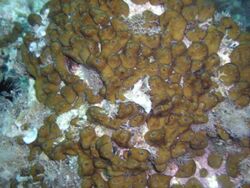Biology:Chondrilla nucula
| Chondrilla nucula | |
|---|---|

| |
| Scientific classification Error creating thumbnail: Unable to save thumbnail to destination
| |
| Domain: | Eukaryota |
| Kingdom: | Animalia |
| Phylum: | Porifera |
| Class: | Demospongiae |
| Family: | Chondrillidae |
| Genus: | Chondrilla |
| Species: | C. nucula
|
| Binomial name | |
| Chondrilla nucula Schmidt, 1862
| |
| Synonyms | |
| |
Chondrilla nucula, sometimes called the Caribbean chicken-liver sponge, is a species of sea sponge belonging to the family Chondrillidae.
It is an amorphous shaped sponge that grows in flat, sometimes bulbous sheets in benthic communities. It is sometimes found in marginal, stressful systems such as caves. Such sponges are white, lacking access to sunlight, and photosymbionts. It is known to be preyed upon by the hawksbill turtle, Eretmochelys imbricata.[1]
The chondrilla nucula species has experienced changes and differences in its morphology over the course of its life, but it is still the same species with similar morphotypes despite these changes and differences.
This sponge has been found to contain strains of bacteria that contained antimicrobial properties. These properties have been shown to inhibit certain bacteria which are harmful to human including Staphylococcus aureus.[2]
References
- ↑ Meylan, Anne (1988-01-12). "Spongivory in Hawksbill Turtles: A Diet of Glass". Science (American Association for the Advancement of Science) 239 (4838): 393–395. doi:10.1126/science.239.4838.393. PMID 17836872. Bibcode: 1988Sci...239..393M.
- ↑ Chelossi, Elizabetta (2007). "Bacteria with Antimicrobial Properties Isolated from the Mediterranean Sponges Chondrilla Nucula and Petrosia Ficiformis". Aquatic Microbial Ecology 49 (2): 157–163. doi:10.3354/ame01134.
- Duran, Sandra; Rützler, Klaus (2006-07-01). "Ecological speciation in a Caribbean marine sponge". Molecular Phylogenetics and Evolution 40 (1): 292–297. doi:10.1016/j.ympev.2006.02.018. ISSN 1055-7903. https://www.sciencedirect.com/science/article/pii/S1055790306000558.
Wikidata ☰ Q2625334 entry
 |

